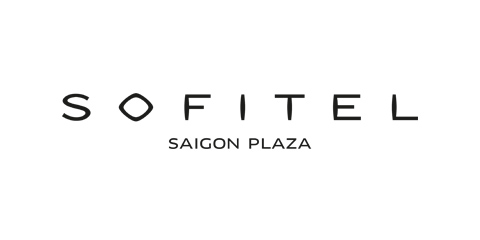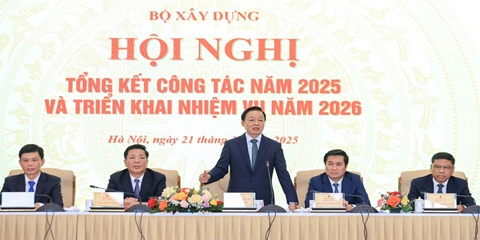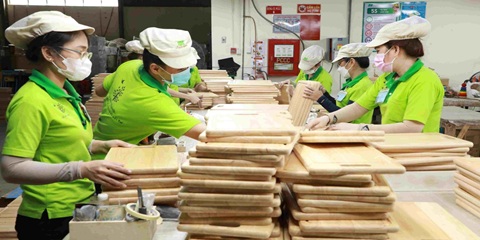Want to be in the loop?
subscribe to
our notification
Business News
SEEKING TECHNOLOGICAL SOLUTIONS FOR VIETNAM GARMENT AND TEXTILE INDUSTRY
Improving manufacturing technologies, localising input materials and cooperating with countries with developed manufacturing technologies is considered a right direction for the garment and textile industry to take advantage of preferential tariff treatments.
This information was released at the “Belgian Technology Solutions for Vietnamese Textile Industry” roadshow which was recently held in Hanoi by the Vietnam Textile and Apparel Association (Vitas) in coordination with the Flanders Investment & Trade Agency (FIT) and the Belgian Textile Machinery Association (Symatex).
Vietnam now has about 4,000 garment and textile companies, including 650 foreign-invested firms. Specifically, 70 per cent are garment companies, 17 per cent are textile companies, 6 per cent are spinning companies, 4 per cent are dyeing companies and 3 per cent are supporting companies. This structure is disproportionate! This shows that Vietnam is very strong in the final stages of “cutting - sewing” while it is very weak in spinning, weaving and dyeing and is unable to supply enough of inputs for domestic garment and textile companies.
According to information at the forum, the domestic garment and textile industry needs about 10 billion square metres of fabric but it can produce just over 3 billion square metres a year due to weak capacity and technology. Applying advanced manufacturing technologies, increasing localisation ratio and improving productivity is vital for the industry to control material resources and take advantage of tariff preferences generated by free trade agreements (FTAs).
Mr Truong Van Cam, Vice President of Vitas, said that Vietnam has signed several FTAs, including very important ones like the EU - Vietnam FTA (EVFTA) and the Trans-Pacific Partnership (TPP). The garment and textile industry has been seen as a top beneficiary of these FTAs when tariffs are brought to zero. Nevertheless, to be beneficial, domestic enterprises must meet the complex rules of origin, e.g. “fabric forward” in EVFTA and “yarn forward” in TPP. Meanwhile, the industry is importing 80 per cent of materials from foreign countries, mostly from non-TPP and non-EVFTA nations. Improving product quality and increasing localisation ratio is the core issue of Vietnam's garment and textile sector.
He added that Vietnam has attracted many new foreign-invested garment and textile projects while domestic companies have spent more in the sector too. However, he noted that they face many land-related difficulties when they invest in Vietnam. Most localities turn down dyeing textile projects on fears of considerable environmental pollution.
Remarking on Belgian textile technologies, he pointed out that Belgian textile technologies are now not strange since many Vietnamese businesses are using them, especially textile equipment. The Flanders region produces the world's fastest air jet looms and always pioneers in electronic and digital technologies applied in garment and textile production inspection, monitoring and control.
Mr Joroen Vist, Director of Symatex, added that Belgium has established cooperation in garment and textile technologies with Vietnam for over 10 years and the country now wants to expand the presence in the Vietnamese market amid rising demand in this industry, especially when Vietnam joins new generation free trade agreements, including EVFTA.
Sharing this point of view, Mr Wouter Vanhees, Trade Counsellor of Flanders Investment and Trade Agency of Belgium (FIT), affirmed that the Belgian textile machinery industry is mainly engaged in production of interior cloths (floor coverings, carpet, upholstery, velvet, tablecloths), textile fabrics and technical textiles. Flanders textile machinery manufacturers always pursue cutting-edge technology strategies. As a result, they are always ranked Top 5 companies with most patents.
In addition to applying advanced technologies and cooperating with countries with advanced garment and textile technologies such as Belgium, delegates to the forum also underscored that Vietnam needs an appropriate dyeing textile development plan for localities. The formation of textile industry clusters will help increase the localisation ratio and reduce costs. Localities also need to prepare good infrastructure for industrial zones like land fund, water drainage and water supply systems.
Also at the forum, Vietnamese companies were informed of the latest development and solutions for weaving and Jacquard weaving, finishing and coating devices, weft insertion systems, production management and garment and textile parts.
Source: VCCI
Related News

A STELLAR CHRISTMAS AT SOFITEL SAIGON PLAZA
Experience the magic of year-end celebrations in five-star luxury, where Parisian elegance meets Saigon’s festive vibrancy. Discover your Stellar Christmas moments: https://sofitel-saigon-plaza.com/festive-offer-2025

CONSTRUCTION SECTOR POSTS OVER 9% GROWTH IN 2025
Industries under the ministry’s management accounted for an estimated 17.23% of national gross domestic product (GDP), up about 0.17 percentage point from 2024. They contributed around 1.96 percentage points to overall GDP growth, reported the Vietnam News Agency. The contribution helped push Vietnam’s economic growth to above 8% in 2025 and supports the Government’s aim of pursuing double-digit growth in the coming years.

VIETNAM PUTS PUBLIC INVESTMENT DISBURSEMENTS AT VND603.6 TRILLION
Vietnam’s public investment disbursements had amounted to VND603.6 trillion in the year to December 18, equivalent to 66.1% of the plan assigned by the prime minister. According to the Ministry of Finance, actual disbursements by December 11 had totaled VND577.7 trillion, or 63.3% of the prime minister-approved plan of VND913.2 trillion, the Vietnam News Agency reported.

SHINE INTO 2026 AT HOIANA RESORT & GOLF!
This New Year’s Eve, celebrate where the sea meets the sky. Vibrant performances, festive dining, DJ beats, live bands and dazzling fireworks come together for one unforgettable night. From beachfront countdown moments to curated New Year’s Eve dinners across Hoiana, every detail is designed to welcome 2026 in style.

VIETNAM’S TRADE SET TO SURPASS US$900 BILLION FOR FIRST TIME
Vietnam’s total import-export turnover is expected to reach about US$920 billion by the end of the year, marking the first time the country’s trade value has exceeded the US$900-billion mark. As of December 15, Vietnam’s total trade turnover stood at US$883.7 billion, according to the Agency of Foreign Trade under the Ministry of Industry and Trade.

GLOBAL SOURCING FAIR VIETNAM 2026 – THE TRULY GLOBAL B2B SOURCING SHOW IN VIETNAM TO EXPAND & DIVERSIFY YOUR EXPORT MARKETS WORLDWIDE
The 4th edition of Global Sourcing Fair Vietnam returns in 2026 with an impressive scale, featuring 700 booths showcasing Fashion & Accessories, Home & Gifts, and the newly introduced Printing & Packaging Products from 500+ verified suppliers across Vietnam and Asia – including Mainland China, Taiwan, Hong Kong SAR, South Korea, India, Bangladesh, ASEAN, and more.
























